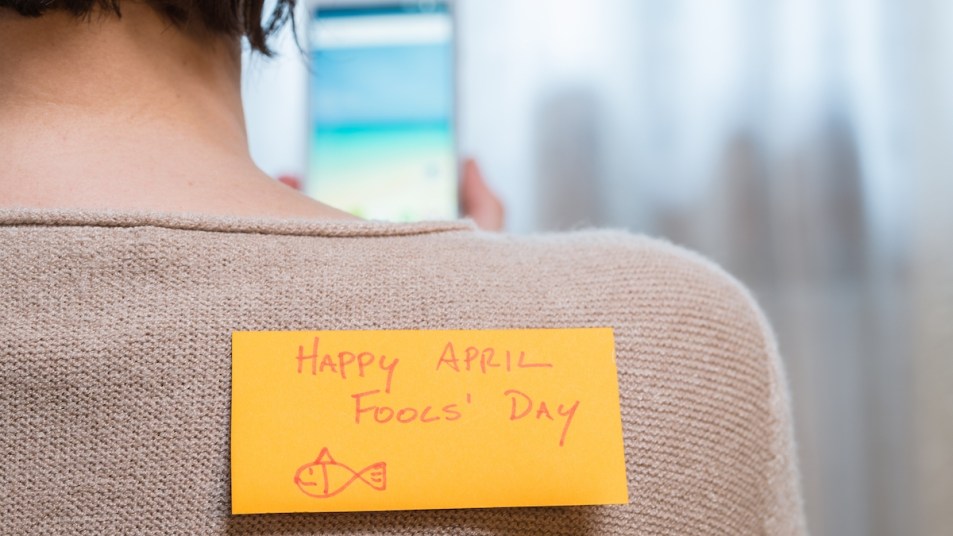5 of the Biggest April Fools’ Day Pranks Ever —From Spaghetti Harvests to Game Show Host Swaps
These April 1 jokesters really went for it.

Ah, April Fools’ Day. Every year, April 1 sneaks up and unleashes a barrage of strange and occasionally hilarious pranks. While you might assume that pranks are just for kids, there are plenty of instances in which adults can enjoy them, too. What makes a good prank? There are a few key factors: It should be creative and unexpected, it should be realistically achievable, and it should be playful rather than mean-spirited.
Telling your partner you’re pregnant when you aren’t? Not a good prank. (It’s too high-stakes an event to lie about, and your partner may react emotionally.) Temporarily swapping out a family portrait with a photograph of your cat wearing a bow tie, and waiting for your family to notice? A good prank. (It’s silly and low-stakes, and won’t cause any strong emotions beyond amusement.)
If you’re planning to pull some pranks yourself this year and need some inspiration — or you just want to learn about some April 1 successes of years past — check out these five big-time, nationwide pranks.
1. When the BBC reported on a spaghetti harvest.
Back in 1957, the BBC news program Panorama aired a report on a “spaghetti harvest” taking place in Switzerland. This two and a half minute “report,” shot in the black-and-white film of the day and narrated in a straight-laced tone by the show’s host, the respected British journalist Richard Dimbeley, is believed to be one of the first-ever televised April Fools’ pranks.
The prank made excellent use of the still fairly new TV format, showing spaghetti hanging off of trees and using matter-of-fact news language to say extremely silly things — just try not to laugh when Dimbeley speaks of “an exceptionally heavy spaghetti crop” and the disappearance of “spaghetti weevil.” Responses to the clip at the time were mixed. While some viewers criticized the BBC for putting a spoof segment on a news show, others were totally fooled. Watch the clip for yourself below — if nothing else, it will make you want spaghetti.
2. When Taco Bell rebranded the Liberty Bell.
Who doesn’t love Taco Bell? Their fast food take on Mexican flavor is legendary, but in 1996 the chain said they were going to branch out, and angered a lot of fans in the process. On April 1 of that year, Taco Bell took out full-page ads in seven major newspapers claiming they had purchased the iconic Liberty Bell in Pennsylvania and planned to rename it “The Taco Liberty Bell.”
While the name “Taco Liberty Bell” is pretty ridiculous, the language of the ad was just plausible enough to fool people. The ad positioned the buying of the Liberty Bell as “an effort to help the national debt,” and concluded, “while some may find this controversial, we hope our move will prompt other corporations to take similar action to do their part to reduce the country’s debt.” The ad led to talk show and news segments and countless angry phone calls. It even reached then-Press Secretary Mike McCurry, who joked that Ford would be renaming the Lincoln Memorial “the Lincoln Mercury Memorial.”
3. When NPR proved people don’t read anymore.
NPR is known for catering to an intellectual audience through its broadcasts and articles. But in 2014, they played a simple prank to prove some of their audience may not be quite as committed to reading as they claim. On April 1, NPR published an article on their site with the title “Why Doesn’t America Read Anymore?” The headline suggested a hard-hitting reported piece, but actually clicking on the article led readers to a page with a short message beginning “Congratulations, genuine readers, and happy April Fools’ Day!”
NPR’s prank proved their point: When the gag article was posted on their Facebook page, it received thousands of angry comments from people eager to defend the fact that they did, in fact, read — thus proving that they hadn’t actually clicked on and read the article.
4. When Big Ben went digital.
Big Ben — the world’s most famous clock — is a British icon. But in 1980, the BBC set out to have some fun with it, claiming on their overseas radio program that the classic analog clock was going to be updated with a digital display. The broadcast also claimed that the first four listeners to call in would receive the original, discarded hands of Ben.
Listeners were fooled by the report, and angry letters from around the world poured in. The BBC ended up having to issue an apology, with their representative, Tony Lightley, admitting that “surprisingly, few people thought it was funny.” The ’80s would bring many technological advancements, so perhaps the idea of a classic landmark going digital simply felt like too much change.
5. When Alex Trebek and Pat Sajak traded places.
Jeopardy! and Wheel of Fortune, programs that run one right after the other, have long been two of the most-watched and well-loved game shows. In 1997, the shows celebrated April Fools’ with some good-natured mischief, and had their hosts switch places. That night, Wheel of Fortune’s Pat Sajak hosted Jeopardy!, while Jeopardy!’s Alex Trebek hosted Wheel of Fortune.
Sajak and Trebek pulled it off with admirably straight faces. For viewers who were used to watching the two shows every week, the switch provided some novelty, especially given that the late, great Trebek’s acerbic nature and Sajak’s enthusiasm have always been at odds. Seeing the two beloved hosts swap places and commit to taking on each other’s roles was just uncanny enough to make a perfect prank. You can check out Sajak’s Jeopardy! intro here, and watch Trebek’s Wheel of Fortune episode in full below.
April Fools’!
Whether you’re the kind of rascal who could give notorious prankster George Clooney a run for his money, or you consider yourself gullible enough to consistently fall for other people’s pranks, we hope these April Fools’ gags from years past put a smile on your face. In a stressful world, a silly prank can turn out to be a surprisingly powerful mood-lifter.
















